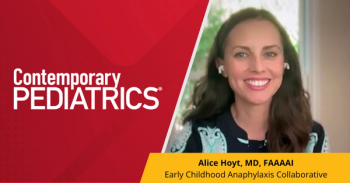
Peanut Allergy: Earlier Exposure-Earlier Reactions
With the banning of peanut butter and jelly from someschool cafeterias, peanut allergies have become a populartopic in the media and the public. Discussions ofteninclude references to an increasing prevalence ofallergies, as well as to an earlier emergence of thoseallergies in children.
Study underscores the importance of prescribing self-injectable epinephrine for all children with potential food allergies.
With the banning of peanut butter and jelly from someschool cafeterias, peanut allergies have become a populartopic in the media and the public. Discussions ofteninclude references to an increasing prevalence ofallergies, as well as to an earlier emergence of thoseallergies in children.
In a study recently published in Pediatrics, Green and colleagues1 investigatedthe characteristics of children with peanut allergies, including theage at first exposure to peanuts and at first allergic reaction. The authorsconducted a retrospective chart review of 140 patients seen in the DukeUniversity pediatric allergy and immunology clinic between July 2000 andApril 2006. Half of the patients were born between 1988 and 1999; the other half were born between2000 and 2005.
The authors considered a diagnosis of peanut allergy to consist of a clinical history consistentwith an allergy as well as a positive result of skin or serum testing. Of the patients studied,66% were boys; 82% had an atopic first-degree relative with either allergic rhinitis, asthma,food allergy, or atopic dermatitis; 68% were allergic to an additional food; 82% had a history ofatopic dermatitis; 57% had allergic rhinitis; and 62% had asthma.
Patients in this study had received a diagnosis of peanut allergy by a physician who referredthem to the allergy clinic. Self-injectable epinephrine had been prescribed for only 44% ofthese patients; 39% experienced an accidental peanut ingestion after the allergy was diagnosed.The median age at first exposure to peanuts was 14 months; the first reaction occurred at amedian age of 18 months.
The median age at which patients were first seen in the allergy andimmunology clinic was 28 months. Boys were seen at an earlier age than girls.
Patients born during or after 2000 were first exposed to peanuts at a median age of 12 months;this compares with 19 months in those born before 2000. Children born in or after 2000 hadtheir first reaction to peanuts at a median age of 14 months, while those born before 2000 first reactedat a median age of 21 months. The time from first exposure to first reaction was not significantlydifferent in the 2 groups.
This study indicates that children are being exposed to peanuts and are reacting to them atyounger ages than in the past. Earlier reactions may be a consequence of earlier exposure.Although allergies may be more likely to be diagnosed because of an increased awarenessamong parents and physicians, the trend is still of concern. Also alarming is the finding that self-injectableepinephrine had been prescribed for fewer than half of the children referred for evaluation.This is especially worrisome given that many of the children reported accidental ingestionsafter diagnosis.
What are the implications for clinical practice? We should counsel parents to follow theAAP recommendations to hold off on peanut exposures until age 3 years in children with a familyhistory of allergies.2 The AAP also recommends that mothers of allergic children avoid exposureto peanuts while breast-feeding and, possibly, during pregnancy. In particular, we mustmake sure that all children with potential food allergies have access to self-injectable epinephrine.By doing so, we may be saving a child's life.
References:
- Zeiger RS. Food allergen avoidance in the prevention of food allergy in infants and children. Pediatrics. 2003;111(6, pt 3):1662-1671.
- Green TD, LaBelle VS, Steele PH, et al. Clinical characteristics of peanut-allergic children: recent changes. Pediatrics. 2007;120:1304-1310.
Newsletter
Access practical, evidence-based guidance to support better care for our youngest patients. Join our email list for the latest clinical updates.








